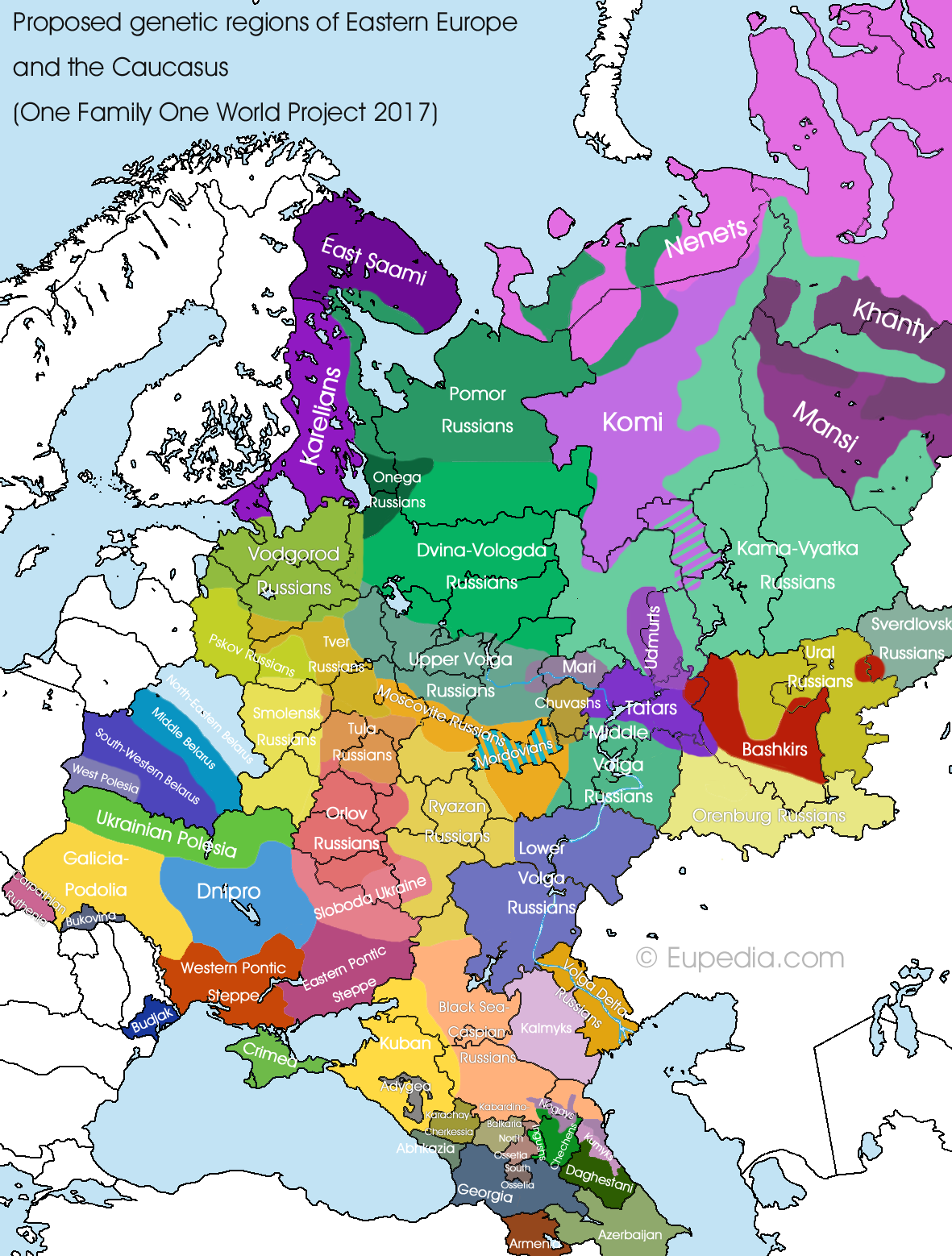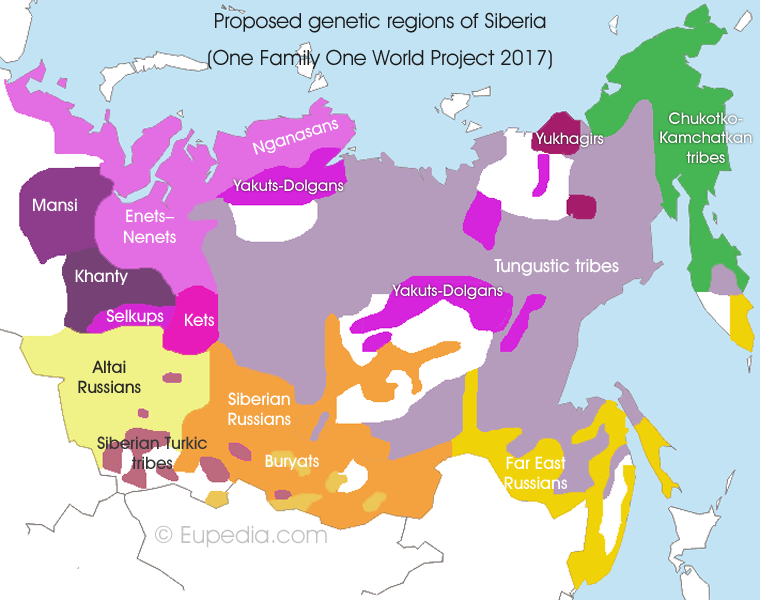One Family Project
The One Family One World Project is a partnership between Living DNA and Eupedia initiated in 2017. The project aims to map the regional genetic variations of the world with a great level of detail and accuracy in order to improve our understanding of both recent and ancient migrations and see how humans are all connected with one another as one big family.
Genetic variations within Eastern Europe, the Caucasus and Siberia
People from the lands that are now Russia, Belarus and Ukraine have played a major role in shaping the modern European gene pool. During the Late Glacial and Mesolithic periods, hunter-gatherers from Europe and Siberia converged in Eastern Europe. Early farmers from Anatolia colonised the Carpathians and eventually expanded to western Ukraine, where Anatolian ancestry is higher to this day.
Historical context
Horses were first domesticated in the Volga-Ural region 6,500 years ago, and the first bronze weapons were invented in the Northwest Caucasus 5,500 years ago. This allowed the Proto-Indo-Europeans, cattle pastoralists from the Pontic-Caspian Steppe, to expand across most of Europe, Central Asia, as well as parts of the Middle East and South Asia.
During the Iron Age, Celtic tribes from around the Alps expanded west and east, some ending up in Ukraine. In the Early Middle Ages, the Slavs started expanding from western Russia, Belarus and Ukraine, spreading their culture and language over most of Central and Southeast Europe. A few centuries later, the Varangians, Vikings from Sweden, established trade settlements between Lake Ladoga and the Black Sea. In 882 they founded the Kievan Rus', which would evolve into the Grand Duchy of Lithuania (including most of present-day Belarus), the Kingdom of Galicia-Volhynia and the Grand Duchy of Moscow, among others.
Proto-Uralic tribes from northern China brought pottery to the Volga-Ural region some 7,000 years ago. They progressively expanded across Northwest Russia, where various Uralic tribes live today, such as as Khanty, Mansi, Nenets, Komi, Finns and Sami. Other Uralic tribes, like the Udmurts and Mari, occupy parts of the Volga-Ural region. Turkic tribes like the Chuvashs and the Bashkirs have a more mysterious origin and are probably a blend of several medieval populations.
In the 13rd century, the Mongols under Genghis Khan created the largest empire the world had ever known. They followed the Eurasian Steppe until Ukraine and briefly conquered parts of European Russia too. The Tatars, one of the five major Mongol tribal confederations, settled in Tatarstan in the Middle Volga region, and in Crimea. More recently, the Kalmyks, a Oirat Mongol tribe, migrated to the Lower Volga region and created the Kalmyk Khanate in 1630. Their descendants now live in Kalmykia. Other Turkic tribes settled in the North Caucasus, including the Karachay-Balkars, who descend from the Kimek Khanate, the Kumyks, who may be descended from the Khazars, and the Nogais, a late offshoot of the Mongolian Empire. Each of these groups are now heavily admixed with older populations from the Caucasus.
The North Caucasus region, and particularly Daghestan, is a rich patchwork of ethnic groups. Along with the Georgians, the North Caucasians possess ancestry can be traced back to the Paleolithic and Mesolithic Caucasus for the most part, with some Indo-European and Turkic admixture found at varying levels.
Objective & Methodology
This project aims at unravelling the regional genetic differences between the various ethnic groups found in European Russia, Belarus and Ukraine. To determine the boundaries between proposed genetic regions we took into account the areas of settlements of ancient and medieval populations, and the places where the various invaders settled most heavily.
We believe that the historical borders of duchies, kingdoms and khanates, as well as the perimeters of the various modern dialects also influenced the way genes spread in the population over time, as people tended to marry much more frequently within the confines of their geographic, political and linguistic boundaries.
Ethnic Russians, Belarusians and Ukrainians were divided by dialects whenever possible, or by region for eastern and northern Russians.
Proposed genetic regions of Eastern Europe, the Caucasus and Siberia
Our preliminary research indicates at least 72 areas of Eastern Europe, the Caucasus and Siberia may have distinct genetic differences.


- Abhkazia
- Adygea
- Altai Russians
- Azerbaijan
- Bashkirs
- Black Sea - Caspian Russians
- Budjak
- Bukovina
- Buryats
- Carpathian Ruthenia
- Chukotko-Kamchatkan Tribes
- Chuvashs
- Crimea
- Daghestani
- Dnipro
- Dvina-Vologda Russians
- Eastern Pontic Steppe
- Enets
- Far East Russians
- Galicia-Podolia
- Georgia
- Ingushs
- Kabardino-Balkaria
- Kalmyks
- Kama-Vyatka Russians
- Karachay-Cherkessia
- Karelians
- Kets
- Khanty
- Komi
- Kuban
- Kumyks
- Lower Volga Russians
- Mansi
- Mari
- Middle Belarus
- Middle Volga Russians
- Mordovians
- Moscovite Russians
- Nenets
- Nganasans
- Nogais
- North Ossetia
- North-Eastern Belarus
- Onega Russians
- Orenburg Russians
- Orlov Russians
- Pomor Russians
- Pskov Russians
- Ryazan Russians
- Saami
- Selkups
- Siberian Russians
- Siberian Turkic Tribes
- Sloboda Ukraine
- Smolensk Russians
- South Ossetia
- South-Western Belarus
- Sverdlovsk Russians
- Tatars
- Tula Russians
- Tungustic Tribes
- Tver Russians
- Udmurts
- Ukranian Polesia
- Upper Volga Russians
- Ural Russians
- Vodgorod Russians
- Volga Delta Russians
- West Polesia
- Western Pontic Steppe
- Yakuts-Dolgans
- Yukhagirs
How do I qualify?
The One Family project is open to everyone worldwide and has two parts.
- 1. To build a genetic family tree of everyone from around the world, regardless of where your family comes from.
- 2. To build a regional genetic breakdown of ancestry within countries, similar to 'The Peopling of the British Isles project'. This part of the project is looking for people with all four grandparents born within 80km (50mi) of each other inside our project areas of interest.
If you have already tested with Living DNA, all you need to do to join the project is log into your account, click on the Research tab and choose to participate in our global ancestry research project, if you haven't already done it.
If you already tested your DNA with another company (23andMe, AncestryDNA, MyHeritage, or FTDNA's Family Finder), you can join the project here for free. After submitting the form with your family information, you will receive an email to confirm the creation of your Living DNA account and will be asked to upload your genome there for free.
If you have not yet tested your DNA with one of the above companies, then you will need to order a Living DNA test to take part.
The data provided as part of the project is kept strictly private and confidential under Living DNA’s ISO:27001 certification for information security. Please read Living DNA's Privacy Policy for more information.